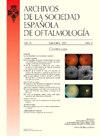伴有和不伴有青光眼的高近视的区别特征
Q3 Medicine
Archivos De La Sociedad Espanola De Oftalmologia
Pub Date : 2025-08-05
DOI:10.1016/j.oftal.2025.04.009
引用次数: 0
摘要
前言与目的探讨高度近视伴青光眼与不伴青光眼患者眼部及流行病学参数的差异。材料与方法从2022年10月至2023年10月在医院会诊中招募了386例诊断为高度近视的患者。高度近视定义为眼轴长度≥26 mm和/或屈光不正≥- 6屈光度。我们进行完整的眼科检查,结合光学生物测量测量眼轴长度和客观屈光来量化屈光不正。结果共纳入386例就诊的高度近视患者(ⅰ组:138例)和青光眼患者(ⅱ组:248例)。两组的性别分布相似。青光眼组的平均年龄略高于非青光眼组,差异无统计学意义(63.8 vs 62.4; P = .349)。青光眼患者的平均屈光不正更高:- 15.52屈光不正vs - 12.75屈光不正,差异有统计学意义(P = 0.002)。青光眼患者的平均眼轴长度明显大于前者:30.21 mm vs 28.93 mm (P < 0.001)。结论研究结果首次提示高度近视患者眼轴长度增加、屈光不正加重与青光眼的发生有直接关系。青光眼的高发率与这些患者的年龄无关,这一点值得特别关注。这些发现强调了提高人们对高度近视患者青光眼患病率增加的认识的重要性。本文章由计算机程序翻译,如有差异,请以英文原文为准。
Características diferenciales en miopía alta con y sin glaucoma
Introduction and objectives
To identify the differences in ocular and epidemiological parameters between highly myopic subjects with and without glaucoma.
Material and methods
A total of 386 patients diagnosed with high myopia were recruited in hospital consultations from October 2022 through October 2023. High myopia was defined as an axial length ≥ 26 mm and/or a refractive error ≥ −6 diopters of sphere. We perform a complete ophthalmological examination, incorporating optical biometry to measure axial length and an objective refraction to quantify refractive error.
Results
386 high myopic patients without (group I: n = 138) and with glaucoma (group II: n = 248) who attended for consultation were included in the study. The distribution by sex was similar in both groups.
The mean age was slightly higher in the glaucoma group than in the subjects without glaucoma, without finding statistically significant differences (63.8 vs 62.4 years; P = .349).
Patients with glaucoma had a higher mean refractive error: −15.52 diopters vs −12.75 diopters finding statistical significance (P = .002). The mean axial length was significantly greater in patients with glaucoma: 30.21 vs 28.93 mm (P < .001).
Conclusions
Our results firstly suggest that increased axial length and greater refractive error are directly related to the prevalence of glaucoma in patients with high myopia. The non-association between a higher prevalence of glaucoma and older age in these patients is of special interest. These findings underscore the importance of increasing awareness of the increased prevalence of glaucoma in people with high myopia.
求助全文
通过发布文献求助,成功后即可免费获取论文全文。
去求助
来源期刊

Archivos De La Sociedad Espanola De Oftalmologia
Medicine-Ophthalmology
CiteScore
1.20
自引率
0.00%
发文量
109
审稿时长
78 days
期刊介绍:
La revista Archivos de la Sociedad Española de Oftalmología, editada mensualmente por la propia Sociedad, tiene como objetivo publicar trabajos de investigación básica y clínica como artículos originales; casos clínicos, innovaciones técnicas y correlaciones clinicopatológicas en forma de comunicaciones cortas; editoriales; revisiones; cartas al editor; comentarios de libros; información de eventos; noticias personales y anuncios comerciales, así como trabajos de temas históricos y motivos inconográficos relacionados con la Oftalmología. El título abreviado es Arch Soc Esp Oftalmol, y debe ser utilizado en bibliografías, notas a pie de página y referencias bibliográficas.
 求助内容:
求助内容: 应助结果提醒方式:
应助结果提醒方式:


